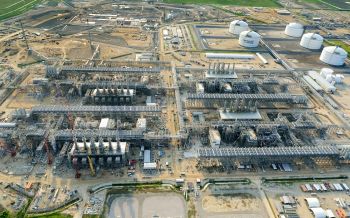When the first wave of US Gulf Coast LNG regasification terminals rushed to convert into liquefaction plants in the early 2010s to tap into the American shale export boom, it is unlikely their backers envisioned pulling a full 360-degree turn just a few years down the line.
But less than a year since the prospect of widespread US LNG shut-ins since first reared its head, US Gulf Coast regas conversions are now staring at price signals potentially calling for them to import cargoes of LNG that fail to find a home in European markets decimated by the Covid-19 pandemic.
As western governments strive to find the appropriate pace to lift lockdowns that have plunged their economies into deep recessions, northern hemisphere natural gas prices have become so contorted that the US Gulf Coast – the heart of North America’s renaissance as an LNG export powerhouse – could briefly steal Europe’s role as the ‘market of last resort’ for surplus LNG.
At last close, CME’s Henry Hub (HH) futures contract for July delivery settled above the same month contract on two main north-west European gas hubs: the UK’s National Balancing Point (NBP) and Dutch Title Transfer Facility (TTF).
HH currently trades at a premium over NBP for every month between now and August 2020, and over TTF for the months of July and August 2020, according to the most recent settlement data from the Chicago Mercantile Exchange (CME) and ICE Data Services (ICE).
July-dated HH is trading at USD 2.13/MMBtu, a premium of USD 0.07/MMBtu over TTF and USD 0.24/MMBtu over NBP. In August, the forward curve puts the HH premium over TTF and NBP at USD 0.06/MMBtu and USD 0.15/MMBtu, respectively.
These margins remain narrow but have widened over the last week. Last Monday, as the world witnessed the main US crude oil price briefly turn negative, front-month HH spiked almost 10% just as prompt NBP crashed by the same degree, causing the US gas benchmark to settle above UK wholesale gas for what is believed to be the first time this millennium. Since then, front-month TTF has crashed more than 13%. The July-dated TTF contracted settled below HH on Tuesday 22 April and remains at a discount.
Meanwhile, onshore US operators are demobilising drilling rigs in response to the crashing US oil price at an alarming rate: 64 rigs came offline last week, according to Baker Hughes, of which 45 were in Texas and New Mexico – home to the Permian shale play that feeds US Gulf Coast gas demand.
With the US oil price threatening to dive back into negative territory, there remains ample scope for further widespread rig mothballing that would remove large volumes of associated gas production from the market, offering support to HH going into the summer months.
Asian saviour?
Many US LNG regasification facilities that converted to exports can still receive and unload LNG cargoes. Cove Point, for example, received four cargoes between December 2019 and January 2020, according to an LNG industry expert source.
Most if not all US LNG conversion projects, such as Cheniere’s Sabine Pass facility in Louisiana, “will have retained the regasifiers so that they can still collect regas fees from the companies that committed to capacity in the heady days when the US was going to be the largest importer,” the source told Gas Matters Today.
“Unloading a ship is not very different from loading – the only difference is that the pumps on the ship are used rather than those in the onshore tanks. Provided the regasifiers have been maintained in working order then importing rather than exporting is not a problem.”
Today’s price signals alone do not appear sufficient to precipitate mass cargo diversions. For a start, the forward price of Platts’ Japan-Korea Marker (JKM) – the most widely used indicator of the Asian LNG spot price – has so far retained a narrow premium over HH for the duration of 2020.
If the futures curve is anything to go by, the Asian premium will dip to a nadir of USD 0.28/MMBtu over HH in May before recovering to USD 0.41/MMBtu in June, USD 0.45/MMBtu in July and USD 0.59/MMBtu in August. That premium rises above a dollar from October.
Even if the JKM premium over HH were to abruptly collapse to zero, this would not cover the cost of transiting a cargo of LNG that was being used as floating storage somewhere in Asia-Pacific through the Panama Canal or around the Magellan Strait to the Gulf of Mexico – or up further north towards New England. But this will give scant comfort to US LNG exporters already grappling with the first big wave of cargo cancellations.
Eurozone doldrums
While some European car manufacturers such as Volkswagen, Fiat Chrysler, Airbus and Renault are tentatively returning to work, others are such as PSA Group – which makes Peugeot, Citroen and Opel vehicles – are deferring the restart decision until sales pick up, Bloomberg reported yesterday.
Moreover, eurozone governments are taking softly-softly approaches to easing lockdowns that are forcing analysts to curb forecasts for economic recovery. Morgan Stanley said in a note today that a recovery to pre-coronavirus GDP levels will not be possible until “some point” in 2022.
Energy-intensive manufacturing will be less proportionately affected than other sectors such as live entertainment, but the “chances are that we’ll see relatively muted growth [between Q4’20 and Q2’21] assuming no medical solution [to Covid-19 is rolled out] until mid-2021,” the investment bank’s researchers said.
Even if eurozone manufacturing roars back into life this summer, suppliers have plenty of cheap molecules to work through before calling for greater imports. European gas storage levels peaked at a record 98% full in October 2019, according to Gas Infrastructure Europe data, and are now still more than 60% full. In both cases, these are decade-long highs.
There are many moving parts to the transatlantic gas price panorama. The eurozone recovery, if not the UK’s, might exceed expectations. A sustained HH premium over north-west European hubs could stimulate drilling of non-associated gas wells in gas-heavy plays such as Appalachia and Haynesville shale basins, rather than widespread resumption of US LNG imports.
But the mere fact that such an outlandish idea is being discussed at all demonstrates the depth of pandemic disruption and risk to business models that form the backbone of the US energy industry. - SK
Subscription Benefits
Our three titles – LNG Business Review, Gas Matters and Gas Matters Today – tackle the biggest questions on global developments and major industry trends through a mixture of news, profiles and analysis.
LNG Business Review
LNG Business Review seeks to discover new truths about today’s LNG industry. It strives to widen market players’ scope of reference by actively engaging with events, offering new perspectives while challenging existing ones, and never shying away from being a platform for debate.
Gas Matters
Gas Matters digs deep into the stories of today, keeping the challenges of tomorrow in its sights. Weekly features and interviews, informed by unrivalled in-house expertise, offer a fresh perspective on events as well as thoughtful, intelligent analysis that dares to challenge the status quo.
Gas Matters Today
Gas Matters Today cuts through the bluster of online news and views to offer trustworthy, informed perspectives on major events shaping the gas and LNG industries. This daily news service provides unparalleled insight by drawing on the collective knowledge of in-house reporters, specialist contributors and extensive archive to go beyond the headlines, making it essential reading for gas industry professionals.





